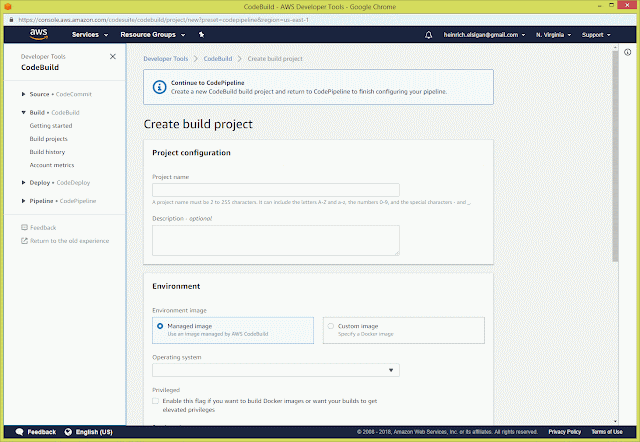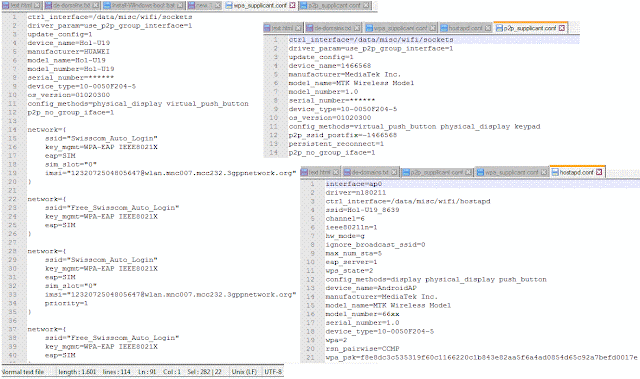This article just shows, how to use some basic functions of the Amazon WebServices SDK under C# .NET with Visual Studio 2013
/*******************************************************************************
* Copyright 2009-2013 Amazon.com, Inc. or
its affiliates. All Rights Reserved.
*
* Licensed under the Apache License,
Version 2.0 (the "License"). You may
* not use this file except in compliance
with the License. A copy of the
* License is located at
*
* http://aws.amazon.com/apache2.0/
*
* or in the "license" file
accompanying this file. This file is
* distributed on an "AS IS"
BASIS, WITHOUT WARRANTIES OR CONDITIONS OF ANY
* KIND, either express or implied. See
the License for the specific
* language governing permissions and
limitations under the License.
*******************************************************************************/
using System;
using System.Collections.Generic;
using System.Collections.Specialized;
using System.Configuration;
using System.IO;
using System.Linq;
using System.Net;
using System.Text;
using System.Threading;
using Amazon;
using Amazon.EC2;
using Amazon.EC2.Model;
using Amazon.EC2.Util;
using Amazon.IdentityManagement;
using Amazon.IdentityManagement.Model;
using Amazon.Auth.AccessControlPolicy;
using Amazon.Auth.AccessControlPolicy.ActionIdentifiers;
using Amazon.S3;
using Amazon.S3.Model;
using Amazon.S3.Util;
namespace AwsEC2Sample1
{
/// <summary>
/// This sample shows how to
launch an Amazon EC2 instance with a PowerShell script that is executed when
the
/// instance becomes available
and access Amazon S3.
/// </summary>
class Program
{
static readonly string RESOURCDE_POSTFIX = DateTime.Now.Ticks.ToString();
static readonly string SAMPLE_PREFIX = AWSConfigSettings.AWSSamplePrefix;
static readonly string SAMPLE_NAME = SAMPLE_PREFIX
+
DateTime.Now.ToShortDateString() + "_" + DateTime.Now.ToShortTimeString().Replace(":", ".");
static readonly string SAMPLE_LONG_UNIQUE_NAME =
SAMPLE_PREFIX + RESOURCDE_POSTFIX;
const bool CREATE_AND_SAVE_KEY_PAIR = true;
public static void Main(string[] args)
{
string awsProfileName = AWSConfigSettings.AWSProfileName;
AmazonEC2Config config = new AmazonEC2Config();
config.ServiceURL = AWSConfigSettings.AWSServiceUrl;
Amazon.Runtime.AWSCredentials credentials = new Amazon.Runtime.StoredProfileAWSCredentials(awsProfileName);
// AmazonEC2Client ec2Client = new
AmazonEC2Client(credentials, config);
AmazonEC2Client ec2Client = new
AmazonEC2Client();
var
bucketName = SAMPLE_LONG_UNIQUE_NAME;
// Get latest 2012 Base AMI
var
imageId = ImageUtilities.FindImage(ec2Client, ImageUtilities.WINDOWS_2012_BASE).ImageId;
Console.WriteLine("Using Image ID: {0}", imageId);
// Create an IAM role
var instanceProfileArn = CreateInstanceProfile();
Console.WriteLine("Created Instance Profile: {0}", instanceProfileArn);
Thread.Sleep(15000);
// Check existing keypairs
string keyPairName = SAMPLE_LONG_UNIQUE_NAME;
var
dkpRequest = new DescribeKeyPairsRequest();
var
dkpResponse = ec2Client.DescribeKeyPairs(dkpRequest);
List<KeyPairInfo> myKeyPairs =
dkpResponse.KeyPairs;
foreach (KeyPairInfo item in myKeyPairs)
{
Console.WriteLine("Existing key pair: " + item.KeyName);
}
// Create new KeyPair
KeyPair newKeyPair = null;
CreateKeyPairRequest newKeyRequest = new CreateKeyPairRequest() { KeyName = keyPairName };
CreateKeyPairResponse ckpResponse =
ec2Client.CreateKeyPair(newKeyRequest);
// store the received new Key
newKeyPair = ckpResponse.KeyPair;
Console.WriteLine();
Console.WriteLine("New key: " + keyPairName);
Console.WriteLine("fingerprint: " + newKeyPair.KeyFingerprint);
Console.WriteLine();
// Save the private key in a .pem file
using
(FileStream s = new FileStream(keyPairName + ".pem", FileMode.Create))
{
using (StreamWriter writer = new StreamWriter(s))
{
writer.WriteLine(newKeyPair.KeyMaterial);
Console.WriteLine(newKeyPair.KeyMaterial);
}
}
string secGroupId = string.Empty;
// Create new security Group
try
{
HttpStatusCode createSecGrCode =
CreateSecurityGroup(ec2Client, ref secGroupId);
}
catch
(AmazonEC2Exception ae)
{
if (string.Equals(ae.ErrorCode, "InvalidGroup.Duplicate", StringComparison.InvariantCulture))
Console.WriteLine(ae.Message);
else throw;
}
// add ip ranges
String ipSource = "0.0.0.0/0";
List<String> ipRanges = new List<String>();
ipRanges.Add(ipSource);
List<IpPermission> ipPermissions = new List<IpPermission>();
IpPermission tcpSSH = new IpPermission() { IpProtocol = "tcp", FromPort = 22, ToPort = 22,
IpRanges = ipRanges };
ipPermissions.Add(tcpSSH);
IpPermission tcpHTTP = new IpPermission() { IpProtocol = "tcp", FromPort = 80, ToPort = 80,
IpRanges = ipRanges };
ipPermissions.Add(tcpHTTP);
IpPermission tcpHTTPS = new
IpPermission() { IpProtocol = "tcp", FromPort = 443, ToPort =
443, IpRanges = ipRanges };
ipPermissions.Add(tcpHTTPS);
IpPermission tcpMYSQL = new
IpPermission() { IpProtocol = "tcp", FromPort = 3306, ToPort =
3306, IpRanges = ipRanges };
ipPermissions.Add(tcpMYSQL);
IpPermission tcpRDP = new IpPermission() { IpProtocol = "tcp", FromPort = 3389, ToPort =
3389, IpRanges = ipRanges };
ipPermissions.Add(tcpRDP);
try
{
// Authorize the ports to be used.
AuthorizeSecurityGroupIngressRequest ipPermissionsRequest = new AuthorizeSecurityGroupIngressRequest();
ipPermissionsRequest.IpPermissions = ipPermissions;
ipPermissionsRequest.GroupName
= SAMPLE_NAME;
if (!string.IsNullOrEmpty(secGroupId)) {
ipPermissionsRequest.GroupId = secGroupId;
}
AuthorizeSecurityGroupIngressResponse authResp =
ec2Client.AuthorizeSecurityGroupIngress(ipPermissionsRequest);
Console.WriteLine("Auth SecurityGroup Request
HttpStatusCode "
+ authResp.HttpStatusCode + " ");
Console.WriteLine(authResp.ResponseMetadata);
}
catch
(AmazonEC2Exception ae)
{
if (String.Equals(ae.ErrorCode, "InvalidPermission.Duplicate", StringComparison.InvariantCulture))
Console.WriteLine(ae.Message);
else
throw;
}
// run ec2 instance request with existing or new generated
keypair
var
runRequest = new RunInstancesRequest
{
ImageId = imageId,
MinCount = 1,
MaxCount = 1,
KeyName = newKeyPair.KeyName, //keyPair.KeyName,
IamInstanceProfile = new IamInstanceProfileSpecification { Arn = instanceProfileArn
},
// Add the region for the S3 bucket and
the name of the bucket to create
UserData = EncodeToBase64(
string.Format(
AWSConfigSettings.POWERSHELL_S3_BUCKET_SCRIPT,
AWSConfigSettings.AWSRegionEndpoint.SystemName,
bucketName)
)
};
// add secGroupId
if
(!string.IsNullOrEmpty(secGroupId)) {
runRequest.SecurityGroupIds.Add(secGroupId);
}
var
instanceId =
ec2Client.RunInstances(runRequest).Reservation.Instances[0].InstanceId;
Console.WriteLine("Launch Instance {0}", instanceId);
// Create the name tag
ec2Client.CreateTags(new CreateTagsRequest
{
Resources = new List<string> { instanceId },
Tags = new List<Amazon.EC2.Model.Tag> { new Amazon.EC2.Model.Tag { Key = "Name", Value = "Processor" } }
});
Console.WriteLine("Adding Name Tag to instance");
// create ElastiCache Cluster
try
{
Amazon.ElastiCache.AmazonElastiCacheConfig eCacheConfig = new Amazon.ElastiCache.AmazonElastiCacheConfig();
eCacheConfig.ServiceURL = AWSConfigSettings.AWSServiceUrl;
Amazon.ElastiCache.AmazonElastiCacheClient eCacheClient = new Amazon.ElastiCache.AmazonElastiCacheClient();
// List<string> x = new
List<string>();
// x.Add(secGroupId);
//
Amazon.ElastiCache.Model.CreateCacheClusterRequest eCacheReq = new
Amazon.ElastiCache.Model.CreateCacheClusterRequest(
//
"cache-cluster" + SAMPLE_NAME, 2, "cache.t2.medium",
"memcached", x);
Amazon.ElastiCache.Model.CreateCacheClusterRequest eCacheReq = new Amazon.ElastiCache.Model.CreateCacheClusterRequest(
"Christian", 2, "cache.t2.medium", "memcached", new List<string>());
Amazon.ElastiCache.Model.CreateCacheClusterResponse eCacheResp =
eCacheClient.CreateCacheCluster(eCacheReq);
Console.WriteLine("Cache Cluster Created" +
eCacheResp.HttpStatusCode.ToString());
}
catch
(Exception ex)
{
Console.WriteLine(ex.Message);
Console.WriteLine();
}
// rds client
Amazon.RDS.AmazonRDSConfig rdsConf = new Amazon.RDS.AmazonRDSConfig();
rdsConf.ServiceURL = AWSConfigSettings.AWSServiceUrl;
Amazon.RDS.AmazonRDSClient rdsClient = new Amazon.RDS.AmazonRDSClient();
// create Database Cluster with aurora DB
string dbClusterIdentifier = string.Empty;
try
{
Amazon.RDS.Model.DBCluster createdCluster =
CreateDBClusterRDS(rdsClient, SAMPLE_NAME, "aurora", "root", SAMPLE_LONG_UNIQUE_NAME,
secGroupId, ref dbClusterIdentifier);
Console.WriteLine("Created DBCluster with Id " +
createdCluster.DBClusterIdentifier);
}
catch
(Exception ex)
{
Console.WriteLine(ex.Message);
Console.WriteLine();
}
Console.WriteLine("Waiting for EC2 Instance to
stop");
// The script put in the user data will shutdown the
instance when it is complete. Wait
// till the instance has stopped which signals the script
is done so the instance can be terminated.
Instance = null;
var
instanceDescribeRequest = new DescribeInstancesRequest { InstanceIds = new List<string> { instanceId } };
do
{
Thread.Sleep(10000);
instance =
ec2Client.DescribeInstances(instanceDescribeRequest).Reservations[0].Instances[0];
if (instance.State.Name == "stopped")
{
// Demonstrate how to get the
Administrator password using the keypair.
var passwordResponse =
ec2Client.GetPasswordData(new GetPasswordDataRequest
{
InstanceId = instanceId
});
// Make sure we actually got
a password
if
(passwordResponse.PasswordData != null)
{
var password =
passwordResponse.GetDecryptedPassword(newKeyPair.KeyMaterial);
Console.WriteLine("The Windows
Administrator password is: {0}", password);
}
}
} while (instance.State.Name == "pending" || instance.State.Name == "running");
// Terminate instance
Console.WriteLine("Terminate Instances " + instanceId.ToString());
ec2Client.TerminateInstances(new TerminateInstancesRequest
{
InstanceIds = new List<string>() { instanceId }
});
// Delete key pair created for sample.
Console.WriteLine("Delete KeyPair " + newKeyPair.KeyName);
ec2Client.DeleteKeyPair(new DeleteKeyPairRequest { KeyName =
newKeyPair.KeyName });
try
{
var s3Client = new AmazonS3Client();
var listResponse = s3Client.ListObjects(new
ListObjectsRequest
{
BucketName = bucketName
});
if (listResponse.S3Objects.Count > 0)
{
Console.WriteLine("Found results file
{0} in S3 bucket {1}",
listResponse.S3Objects[0].Key, bucketName);
}
// Delete bucket created for sample.
AmazonS3Util.DeleteS3BucketWithObjects(s3Client,
bucketName);
Console.WriteLine("Deleted S3 bucket created for
sample.");
}
catch
(Exception ex)
{
Console.WriteLine(ex.Message);
Console.WriteLine();
}
// delete DB Cluster
try
{
HttpStatusCode delClusterStatus =
DeleteDBClusterRDS(rdsClient, dbClusterIdentifier);
Console.WriteLine("Delete Cluster Request with Id
" +
dbClusterIdentifier + " returned " + delClusterStatus.ToString());
}
catch
(Exception ex)
{
Console.WriteLine(ex.Message);
Console.WriteLine();
}
Thread.Sleep(1000);
Console.WriteLine("Delete Instance Profile created for sample.");
DeleteInstanceProfile();
// delete Security Group
try
{
HttpStatusCode delSecGroupStatus =
DeleteSecurityGroup(ec2Client, secGroupId);
Console.WriteLine("Delete SecurityGroup " + secGroupId + " returned " +
delSecGroupStatus.ToString());
}
catch
(Exception ex)
{
Console.WriteLine(ex.Message);
Console.WriteLine();
}
Console.WriteLine("Instance terminated, push enter to exit the
program");
Console.Read();
}
/// <summary>
/// CreateSecurityGroup
/// </summary>
/// <param name="ref
ec2Client"></param>
/// <param
name="secGroupId"></param>
/// <returns>HttpStatusCode</returns>
static HttpStatusCode CreateSecurityGroup(AmazonEC2Client ec2Client, ref string secGroupId)
{
CreateSecurityGroupRequest securityGroupRequest = new CreateSecurityGroupRequest();
securityGroupRequest.GroupName =
SAMPLE_NAME;
securityGroupRequest.Description =
SAMPLE_LONG_UNIQUE_NAME;
CreateSecurityGroupResponse secRes =
ec2Client.CreateSecurityGroup(securityGroupRequest);
Console.WriteLine("Created security Group with GroupId " + secRes.GroupId);
secGroupId = secRes.GroupId;
Console.WriteLine(secRes.ResponseMetadata);
return secRes.HttpStatusCode;
}
/// <summary>
/// CreateDBClusterRDS
/// </summary>
/// <param
name="rdsClient"></param>
/// <param
name="databaseName"></param>
/// <param
name="databaseEngine"></param>
/// <param
name="MasterUsername"></param>
/// <param
name="MasterUserPassword"></param>
/// <param
name="secGroupId"></param>
/// <param name="ref
dbClusterIdentifier"></param>
/// <returns></returns>
static Amazon.RDS.Model.DBCluster
CreateDBClusterRDS(Amazon.RDS.AmazonRDSClient rdsClient,
string databaseName,
string databaseEngine,
string MasterUsername,
string MasterUserPassword,
string secGroupId, ref string dbClusterIdentifier)
{
Amazon.RDS.Model.CreateDBClusterRequest createClusterReq = new Amazon.RDS.Model.CreateDBClusterRequest();
createClusterReq.DatabaseName =
databaseName;
createClusterReq.DBClusterIdentifier = dbClusterIdentifier;
createClusterReq.Engine =
databaseEngine;
if
(!string.IsNullOrEmpty(secGroupId))
{
createClusterReq.VpcSecurityGroupIds.Add(secGroupId);
}
createClusterReq.MasterUserPassword
= MasterUserPassword;
createClusterReq.MasterUsername =
MasterUsername;
Amazon.RDS.Model.CreateDBClusterResponse createClusterResp =
rdsClient.CreateDBCluster(createClusterReq);
Amazon.RDS.Model.DBCluster createdCluster =
createClusterResp.DBCluster;
dbClusterIdentifier =
createdCluster.DBClusterIdentifier;
return createdCluster;
}
/// <summary>
/// DeleteDBClusterRDS
/// </summary>
/// <param
name="rdsClient">Amazon.RDS.AmazonRDSClient</param>
/// <param
name="dbClusterIdentifier">Identifier of RDS DatabaseCluster 2 delete</param>
/// <returns>HttpStatusCode</returns>
static HttpStatusCode
DeleteDBClusterRDS(Amazon.RDS.AmazonRDSClient rdsClient, string dbClusterIdentifier)
{
if
(!string.IsNullOrEmpty(dbClusterIdentifier))
{
throw new ArgumentException("Null or Empty
DBClusterIdentifier which is needed for
Amazon.RDS.Model.DeleteDBClusterRequest", "string dbClusterIdentifier");
}
Console.WriteLine("Deleting DeleteDBClusterRDS with identifier " + dbClusterIdentifier);
Amazon.RDS.Model.DeleteDBClusterRequest delClusterReq = new Amazon.RDS.Model.DeleteDBClusterRequest();
delClusterReq.DBClusterIdentifier =
dbClusterIdentifier;
Amazon.RDS.Model.DeleteDBClusterResponse delClusterResp =
rdsClient.DeleteDBCluster(delClusterReq);
return delClusterResp.HttpStatusCode;
}
/// <summary>
/// DeleteSecurityGroup
/// </summary>
/// <param
name="ec2Client">EC2Client</param>
/// <param
name="securityGroupId">Identifier of SecurityGroup 2 delete</param>
/// <returns>HttpStatusCode</returns>
static HttpStatusCode DeleteSecurityGroup(AmazonEC2Client ec2Client, string securityGroupId)
{
if
(!string.IsNullOrEmpty(securityGroupId))
{
throw new ArgumentException("Null or Empty
securityGroupId which is needed for
Amazon.EC2.Model.DeleteSecurityGroupRequest", "string securityGroupId");
}
Console.WriteLine("Deleting SecurityGroup " + securityGroupId);
DeleteSecurityGroupRequest delSecGroupReq = new DeleteSecurityGroupRequest();
delSecGroupReq.GroupId =
securityGroupId;
DeleteSecurityGroupResponse delSecGroupResp =
ec2Client.DeleteSecurityGroup(delSecGroupReq);
return delSecGroupResp.HttpStatusCode;
}
/// <summary>
/// Create instance profile
& grant EC2 instance requesting S3 bucket
/// </summary>
///
<returns></returns>
static string CreateInstanceProfile()
{
var
roleName = SAMPLE_NAME;
var
client = new AmazonIdentityManagementServiceClient();
client.CreateRole(new CreateRoleRequest
{
RoleName = roleName,
AssumeRolePolicyDocument = @"{""Statement"":[{""Principal"":{""Service"":[""ec2.amazonaws.com""]},""Effect"":""Allow"",""Action"":[""sts:AssumeRole""]}]}"
});
var
statement = new
Amazon.Auth.AccessControlPolicy.Statement(
Amazon.Auth.AccessControlPolicy.Statement.StatementEffect.Allow);
statement.Actions.Add(S3ActionIdentifiers.AllS3Actions);
statement.Resources.Add(new Resource("*"));
var
policy = new Policy();
policy.Statements.Add(statement);
client.PutRolePolicy(new PutRolePolicyRequest
{
RoleName = roleName,
PolicyName = "S3Access",
PolicyDocument =
policy.ToJson()
});
var
response = client.CreateInstanceProfile(new
CreateInstanceProfileRequest
{
InstanceProfileName = roleName
});
client.AddRoleToInstanceProfile(new AddRoleToInstanceProfileRequest
{
InstanceProfileName = roleName,
RoleName = roleName
});
return response.InstanceProfile.Arn;
}
/// <summary>
/// Delete the instance profile
created for the sample.
/// </summary>
static void DeleteInstanceProfile()
{
var
roleName = SAMPLE_NAME;
var
client = new AmazonIdentityManagementServiceClient();
client.DeleteRolePolicy(new DeleteRolePolicyRequest
{
RoleName = roleName,
PolicyName = "S3Access"
});
client.RemoveRoleFromInstanceProfile(new
RemoveRoleFromInstanceProfileRequest
{
InstanceProfileName = roleName,
RoleName = roleName
});
client.DeleteRole(new DeleteRoleRequest
{
RoleName = roleName
});
client.DeleteInstanceProfile(new DeleteInstanceProfileRequest
{
InstanceProfileName = roleName
});
}
static string EncodeToBase64(string str)
{
byte[]
toEncodeAsBytes = System.Text.Encoding.UTF8.GetBytes(str);
string returnValue = System.Convert.ToBase64String(toEncodeAsBytes);
return returnValue;
}
}
/// <summary>
/// AWSConfigSettings Helper Facade
///
</summary>
internal static class AWSConfigSettings
{
const string PROTO = "https://";
const string DOMAIN = "amazonaws.com"; //amazonaws.com
const char DOT = '.';
/// <summary>
/// PowerShell script for
creating S3 bucket and allowing write access to it
/// </summary>
internal const string POWERSHELL_S3_BUCKET_SCRIPT
=
"<powershell>\n" +
"Import-Module \"C:\\Program
Files (x86)\\AWS
Tools\\PowerShell\\AWSPowerShell\\AWSPowerShell.psd1\"\n" +
"Set-DefaultAWSRegion {0}\n" +
"New-Item C:\\Windows\\Temp -type
directory\n"
+
"Add-Content -path
C:\\Windows\\Temp\\s3-bucket-results.txt -value \"Results from lots of
data processing\"\n" +
"New-S3Bucket -BucketName
{1}\n" +
"Write-S3Object -BucketName {1}
-File C:\\Windows\\Temp\\s3-bucket-results.txt -Key results.txt\n" +
"shutdown.exe /s\n" +
"</powershell>";
/// <summary>
/// Gets AWSAppSettings from
Configuration
/// </summary>
internal static NameValueCollection AWSAppSettings
{
get
{
return System.Configuration.ConfigurationManager.AppSettings;
}
}
/// <summary>
/// Gets value stored at
AWSAppSettings[key]
/// </summary>
/// <param
name="key">key
string from KeyValuePair of Configuration AppSettings</param>
/// <returns>value string</returns>
internal static string AWSConfigGetKey(string key)
{
string awsValue = null;
foreach (var nextKey in AWSConfigSettings.AWSAppSettings.Keys)
{
if (nextKey.ToString() == key)
{
awsValue = AWSConfigSettings.AWSAppSettings.Get(key);
if (!string.IsNullOrEmpty(awsValue))
{
return awsValue;
}
throw new ConfigurationErrorsException(
String.Format("AWSConfigSettings.AWSAppSettings[\"{0}\"]
returns null or void Value", key),
new NullReferenceException(String.Format("AWSConfigSettings.AWSAppSettings[\"{0}\"]
is \'\\0\' || \"\"", key))
);
}
}
throw
new ConfigurationErrorsException(
String.Format("AWSConfigSettings.AWSAppSettings[\"{0}\"]
contains no key {1} not found inside
<configuration>[...]<appSettings>[...]", key, key),
new NullReferenceException(String.Format("AWSConfigSettings.AWSAppSettings[\"{0}\"]
is \'\\0\' (null)",
key))
);
}
/// <summary>
/// Gets AWSProfileName from
ConfigSettings
/// </summary>
public static string AWSProfileName
{
get
{
return AWSConfigSettings.AWSConfigGetKey("AWSProfileName");
}
}
/// <summary>
/// Gets AWSRegion from
ConfigSettings
/// </summary>
public static string AWSRegion
{
get
{
string region = "eu-central-1";
try
{
region = AWSConfigSettings.AWSConfigGetKey("AWSRegion");
}
catch (Exception)
{
region = "ap-southeast-2";
}
return region;
}
}
/// <summary>
/// Gets Amazon.RegionEndpoint
from ConfigSettings
/// </summary>
public static Amazon.RegionEndpoint AWSRegionEndpoint
{
get
{
string compareRegion = AWSConfigSettings.AWSRegion.Replace("_", string.Empty).ToLower();
foreach (Amazon.RegionEndpoint endpoint in Amazon.RegionEndpoint.EnumerableAllRegions)
{
if
((endpoint.DisplayName.ToLower() == AWSConfigSettings.AWSRegion.Replace("_", string.Empty).ToLower()) ||
(endpoint.SystemName.ToLower() == AWSConfigSettings.AWSRegion.Replace("_", string.Empty).ToLower()) ||
(endpoint.ToString().ToLower() == AWSConfigSettings.AWSRegion.Replace("_", string.Empty).ToLower()))
{
return endpoint;
}
}
return Amazon.RegionEndpoint.EUWest1;
}
}
/// <summary>
/// Gets AWSServiceUrl from
ConfigSettings
/// </summary>
public static String AWSServiceUrl
{
get
{
string serviceUrl = String.Concat(
PROTO.ToString(),
AWSConfigSettings.AWSRegion,
((DOMAIN[0] != DOT) ?
DOT.ToString() : string.Empty),
DOMAIN.ToString()
);
return serviceUrl;
}
}
/// <summary>
/// Gets AWSServiceUri from
ConfigSettings
/// </summary>
public static Uri AWSServiceUri
{
get
{
return (new Uri(AWSConfigSettings.AWSServiceUrl, UriKind.Absolute));
}
}
/// <summary>
/// Gets AWSSamplePrefix from
Configuration
/// </summary>
public static string AWSSamplePrefix
{
get
{
return AWSConfigSettings.AWSConfigGetKey("AWSSamplePrefix");
}
}
/// <summary>
/// Gets AWSAccessKey from
Configuration
/// </summary>
public static string AWSAccessKey
{
get
{
return AWSConfigSettings.AWSConfigGetKey("AWSAccessKey");
}
}
/// <summary>
/// Gets AWSSecretKey from
Configuration
/// </summary>
public static string AWSSecretKey
{
get
{
return AWSConfigSettings.AWSConfigGetKey("AWSSecretKey");
}
}
}
}





























